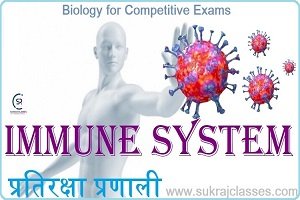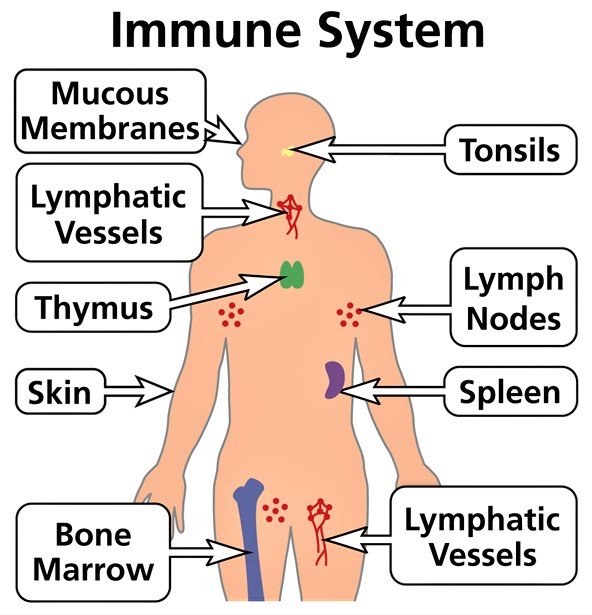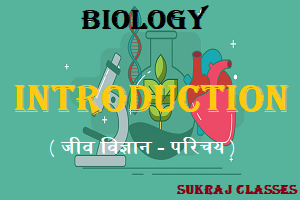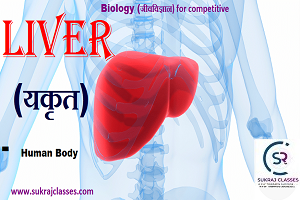
Immune System of Human body (प्रतिरक्षा तंत्र)- Biology
Biology topic- “Immune System of Human body (प्रतिरक्षा तंत्र)”, is important for all competitive exams like CET, SSC CGL, SSC CHSL, RRB NTPC, UPSC and for other state civil service exams. In these exams, almost 4-5 questions are coming from Biology. Let’s start the topic- Immune System of Human body (प्रतिरक्षा तंत्र):
Immune System of Human body
(प्रतिरक्षा तंत्र)
Our immune system helps to protect us against diseases caused by tiny invaders (called pathogens) such as viruses, bacteria, and parasites. The immune system is made up of specialized organs, cells, and tissues that all work together to destroy these invaders. Some of the main organs involved in the immune system include the spleen, lymph nodes, thymus, and bone marrow. Immunity to some diseases is passed on from our mothers before we are born.
Working of Immune System:
Our immune system develops all kinds of cells that help to destroy disease causing microbes. Some of these cells are specifically designed for a certain kind of disease. All throughout the body, disease fighting cells are stored in the immune system waiting for the signal to go to battle.
The immune system is able to communicate throughout the entire body. When pathogens are detected, messages are sent out, warning that the body is being attacked. The immune system then directs the correct attacking cells to the problem area to destroy the invaders.
Antigens (प्रतिजन) and Antibodies (प्रतिपिंड)
Scientists call the invaders that can cause disease antigens. Antigens trigger an immune response in the body. One of the main immune responses is the production of proteins that help to fight off the antigens. These proteins are called antibodies.
Antibodies are designed with specific binding sites that only bind with certain antigens. They ignore “good” cells and only attack the bad ones.
Types of Immunity:
The immune system is very smart and can adapt to new infections. Our bodies gain immunity in two ways: active immunity and passive immunity.
- Active immunity – When our bodies develop immunity over time through the immune system this is called active immunity. Whenever we are exposed to a disease (and sometimes get sick), the immune system learns how to fight off the disease. The next time that disease invades, our body is ready for it and can quickly produce antibodies to prevent infection. We can also gain active immunity from vaccines.
- Passive immunity – When we are born, our bodies may already have some immunity. Babies get antibodies from their mother as they are growing in the womb. They may also gain some antibodies from their mother’s milk. It is also possible to get antibodies from an animal or another person through immunoglobulin treatments. These are all passive immunities because they weren’t developed by our body’s own immune system.
Immune System anatomy:
Everybody has an inbuilt immune system which protects it from germs. This system has a lot of different parts which work together to keep out any harmful germs, and attack and destroy any which manage to get inside our body. Our immune system has cells that perform specific functions. These cells are found in the blood stream and are called white blood cells.
So, let’s have a look at the immune system, starting from the outside of the body.
Skin:
The skin is the first line of defense in our immune system that wrap to keep germs from getting into our body.
- The epidermis (outside layer of skin) has special cells which warn the body about incoming germs.
- Glands in the skin also make substances that can kill some bacteria (anti-bacterial chemicals). This means we don’t get infections on our skin unless our skin is damaged, such as by a cut or a graze.
Lymphatic system (लसीकातंत्र)
- Lymph (लसीका) is a clear fluid that is very similar to blood plasma, the clear liquid in blood, but it carries only white blood cells, not red blood cells.
- The lymph flows through all the parts of the body picking up fluid around cells and carrying it back to large veins near the heart. It also carries white blood cells to the places where they are needed.
- Some bacteria or viruses that have entered the body are collected by the lymph and passed on to the lymph nodes where they are filtered out and destroyed. Lymph nodes are sometimes called glands.
White blood cells (सफेद रक्त कोशिकायें)
In our blood we have red blood cells and white blood cells, and in lymph there are white blood cells.
- There are several different types of white cells which work together to seek out and destroy bacteria and viruses.
- All of them start off in the bone marrow, growing from ‘stem cells’.
The disease-fighting white blood cells are specialists. Some of the white blood cells are:
- Neutrophils, which move around the body in the blood and seek out foreign material (things that don’t belong in your body).
- Macrophages are the biggest blood cells. Some live in different parts of the body and help to keep it clean, eg. In the lungs. Others swim around cleaning up other white blood cells that have been damaged while doing their jobs, eg. Cleaning up pus that has been caused by neutrophils when they work to clear out bacteria from a wound.
- Lymphocytes work on bacterial and viral infections.
There are two different types of lymphocytes:
-
- B cells – B cells are also called B lymphocytes. These cells produce antibodies that bind to antigens and neutralize them. Each B cell makes one specific type of antibody. For example, there is a specific B cell that helps to fight off the flu.
-
- T cells – look for cells in your body that are hiding invaders (germs) or body cells that are different to normal healthy cells (such as cells that could develop into a cancer) and kill them.
-
-
- T cells – T cells are also called T lymphocytes. These cells help to get rid of good cells that have already been infected.
- Helper T cells – Helper T cells tell B cells to start making antibodies or instruct killer T cells to attack.
- Killer T cells – Killer T cells destroy cells that have been infected by the invader.
-
4. Memory cells – Memory cells remember antigens that have already attacked the body. They help the body to fight off any new attacks by a specific antigen.
Other defenses for immunity:
Our nose, mouth and eyes are the next point of attack.
- The mucous membranes which line the mouth, throat, lungs and bowel, act like a barrier to germs, just as the skin does. The mucous that is made in our nose, throat and lungs traps bacteria, viruses and dust.
- Saliva in the mouth and the tears which wash our eyes have special enzymes (chemicals) in them which break down the cell walls of many bacteria and viruses.
- Acid in our stomach kills most germs, and starts to digest our food.
How does our immune system know which cells to attack?
Our body has lots of friendly bacteria around it which help our body work properly – eg. Some bacteria inside our bowel help us to digest our food and break it up into the different things that are needed in various parts of the body. These friendly bacteria live on the surfaces of the body, such as on our skin or inside the bowel. They do not try to invade the body, so the immune system does not try to get rid of them.
- Other germs which cause illness, try to enter the body.
- Antibodies, which are made by the lymphocytes, attach to the invaders so that the other white blood cells can destroy them. They ‘tag’ them so they can be easily noticed. Our immune system recognizes and destroys other cells which do not belong in our body.
- The cells in our own body are marked with a special system called Human Leukocyte Antigen or HLA. For example, we have a blood transfusion with the wrong types of blood cells. Our body’s immune system recognizes that these cells do not belong to our body, so it destroys them.
Sometimes the immune system makes a mistake.
- If tissue is transplanted from one person to another – eg. a skin or kidney transplant – then the immune system will attack the new part. The immune system has to be suppressed by drugs to allow the transplant to work.
- When the immune system is damaged, such as when people have a serious illness called AIDS, they get lots of infections and are much more likely to get cancers. Their body cannot recognize the infection or abnormal cells very well and the immune system does not destroy them as well as usual.
How Vaccines Work to enhance immunity:
Vaccines introduce microbes that are already killed or modified so we don’t get sick. However, the immune system doesn’t know this. It builds up defenses and antibodies against the disease. When the real disease tries to attack, our body is ready and can quickly neutralize the antigens.
Read Also: Genetics/Heredity (आनुवंशिकता)-Competitive Biology
Immune System Facts for Competitive Exams
- The immune system is a biological system that protects the human body from pathogens and ready to defend against any microorganism that invades the body.
- Pathogens that the immune system can defend against include viruses, bacteria and fungus.
- Organs include in our Immune system are: – Adenoid, appendix, bone marrow, lymphatic vessels, lymph nodes, spleen, thymus and the tonsils etc.
- There are two main components to the immune system, the innate immune system and the adaptive immune system.
- The innate immune system provides an immediate, but non-specific response to a pathogen.
- The adaptive immune system is activated by the innate immune system and provides a specific response to a pathogen.
- The adaptive immune system can create an immunological memory, which means it can remember how it responded to a pathogen in the past and deploy the same defense mechanism.
- White blood cells, also known as leukocytes, are cells created by the immune system in bone marrow.
- There are five types of white blood cells and they are basophils, eosinophils, lymphocytes, monocytes and neutrophils.
- Different people have different levels of immunity to certain diseases. This is why some people get sick more often than others.
- Sometimes the immune system can get confused and attack good cells. Type-I diabetes is caused when T cells attack insulin producing cells in the pancreas.
- T cells and B cells are stored in lymph nodes throughout the body. They enter the blood stream when they are needed to defend against disease.
- Our body responds much faster and stronger the second time it sees an antigen.
- A fever is caused by our immune system, not the infection. Our body increases its temperature to activate the immune system and create an environment that’s harder for viruses and bacteria to thrive.
- Allergies are caused by the human immune system. Harmless things like pollen or a specific type of food are interrupted by the immune system as a pathogen and launch an immune response, which results in allergy symptoms.
- Sleep is important for a healthy immune system and poor sleeping habits can weaken our immune system.
For More:
If you like and think that Biology topic on ” Immune System of Human body (प्रतिरक्षा तंत्र)” is helpful for you, Please comment us. Your comments/suggestions would be greatly appreciated. Thank you to be here. Regards – Team SukRaj Classes.





